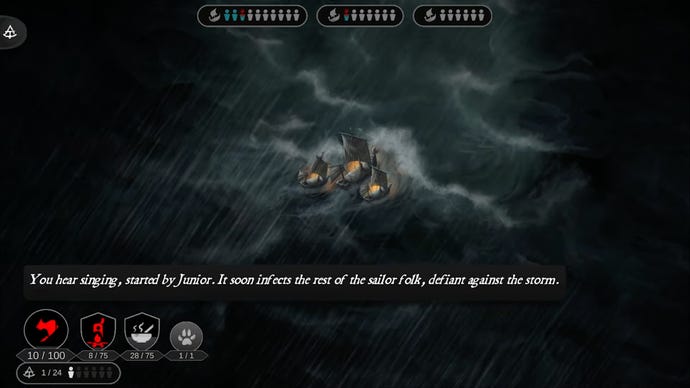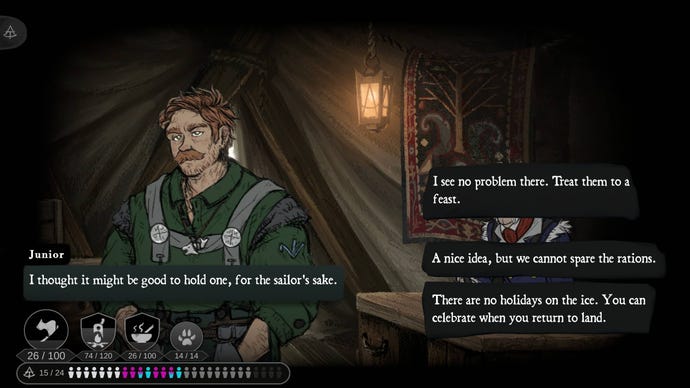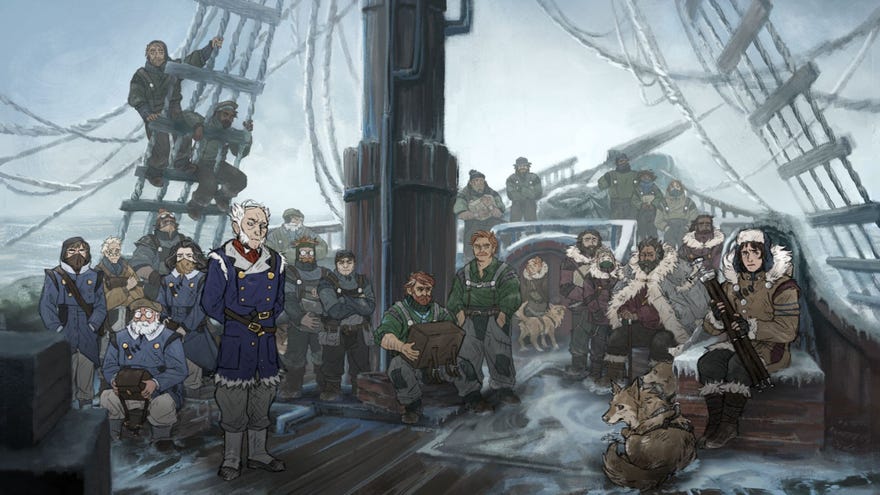How The Pale Beyond charts its own course from a melting pot of real-life polar expeditions
Bellular Studios on the mix of inspirations for their grim survival story
"What will ye do, when steel hearts break, and courage does abscond?" reads the penultimate line of The Pale Beyond’s poetic prologue. Actually, it’s less of a poem and more a call to action: how on earth will you keep a ragtag bunch of sailors alive in the harshest conditions on the planet? If you hadn’t already twigged, The Pale Beyond is a narrative survival sim that puts you in the frostbitten boots of First Mate aboard The Temperance - a coal guzzling steam ship that set out on a polar expedition in search of its sister, The Viscount, which went missing five years prior. As Captain Hunt’s second-in-command, you’ll take daily requests from the crew, manage the food rations, and settle petty squabbles on the poop deck.
Beginning life as a way for co-founders Michael Bell and Thomas Hislop to create World of Warcraft mods, Bellular Studios grew alongside its gaming and Warcraft YouTube channels into a fully-fledged development team based out of their hometown of Belfast, Northern Ireland. The Pale Beyond is their debut game that fittingly draws on Ireland’s rich maritime history, although, as Hislop tells me, this wasn’t always the plan. "We initially didn’t set out to do so, but it quickly emerged as a core influence that we kept finding ourselves drawn back to," he says. "The further we delved into the golden age of exploration, and its very local routes, the more it resonated with us personally."
In fact, one of the Studio’s initial touchstones was the 1914 Imperial Trans-Antarctic Expedition, led by Anglo-Irish explorer Ernest Shackleton. Shackleton's ship, the Endurance, was crushed by frozen seas while attempting to traverse the continent, forcing the crew to set up camp on the ice. "There’s a very long-standing Irish and British history among these expeditions," says Hislop, "and it quickly found its way into every aspect of the game."
While the golden era of Antarctic exploration served as inspiration for The Pale Beyond, the studio was keen to avoid making a period piece. "Setting the game in a historically adjacent fantasy setting allowed us to draw inspiration from a variety of different expeditions and periods of history. We also chose to do this early in development so as to try and draw the player into the moment," Hislop explains. Taking this approach adds real weight to the decisions you make, not least because the crew’s chance of survival is solely down to your actions in the here and now, rather than those already written about in the history books. "We wanted [players] to feel they were on this journey in real time without knowing the outcome, rather than viewing events through an obfuscated historical lens," he adds.
"Setting the game in a historically adjacent fantasy setting allowed us to draw inspiration from a variety of different expeditions"
The decision to have The Pale Beyond inhabit a historically adjacent setting not only allows the player to carve out their own adventure, but it questions the very accuracy of the recording of history, and, importantly, who gets to write it. Take Kurt, The Pale Beyond’s larger-than-life Navigator who revels in his own celebrity through tales of bravery and death-defying encounters on the ice. Of course, not all the crew are so quick to take him at his word, with some more than poised to gleefully call out his bullshit. After one such fight with a scrappy engineer, Kurt tries to persuade the ship’s photographer and journalist, Kasha, to destroy evidence of the scuffle to maintain his public image. Kasha, though horrified at the suggestion, leaves the decision to you.
The subjective nature of these historical records was something Hislop realised early on in his research, and explains that "many of the accounts are often written from that more educated leadership perspective. It was an interesting challenge to find more perspectives we could contrast again to get a more full picture of the story." To achieve this, the team looked to the photographs taken on the Endurance expedition by the ship’s photographer, Frank Hurley. As Jess Campbell, Bellular Studios’ Art Director explained: "The painterly backgrounds and sketchy characters were partially chosen because of the presence of an artist/photographer on board. With legacy being such a strong theme, we wanted it to feel like the game could be an account of what had happened by someone who was there." It was important then that players get to observe first-hand the experiences that working-class crew members might have had onboard a real-life polar expedition. In fact, the Studio extended this idea into a morale-boosting mechanic whereby melancholy crew members can be sent to spend the day with Kasha, who meticulously documents their personal experience of the expedition and throws in something of a photoshoot for good measure.

Hislop, on the other hand, turned to Hoosh, a non-fiction account describing the culinary history of Antarctica. "It was a great example [that gave] insight into the 'second-most important person on the ship', the cooks," he tells me, "who were often from more working class, less educated backgrounds, but held implicit power over the fates of their peers." Indeed, getting The Pale Beyond’s cook, Junior, on your side (not least by keeping the hoosh pot replenished - hoosh being a suspect porridge made of meat, fat and snow) is one of the few ways to woo his standoffish older brother, Grimley, who has a large sway over the working-class crew members.
Even in The Pale Beyond’s fictional world, then, class pervades. The Temperance’s crew, for example, comprises the Saltborn – working class sailors born of the sea – and Landborn – the educated middle-class who occupy the higher-ranking Officer roles. Similarly, differences in class are evident from the clothing and uniform in the photographs of Shackleton’s Endurance crew, which served as Campbell’s first point of reference when considering The Pale Beyond’s art design. "This resulted in a look that was too naturalistic though, and lacked its own strong visual identity, so we started to pull from more unusual sources," she explains. "For the Saltborn, we looked at Celtic clothing and mythology because of our own heritage and because of the large involvement of Irish people in the history of expeditions." Campbell also looked to Norse iconography when designing the Saltborn, which she chose because of the Vikings’ sea-fairing history. "This was contrasted with the British naval influence in the look of the Landborn – choices [we] made to ensure the class divide was visually clear in how characters presented themselves."

Indeed, the real challenge in The Pale Beyond is not just keeping people alive but keeping them together, despite their differences. A few weeks into your expedition, for example, Captain Hunt abandons ship, taking a handful of supplies and crew in one of the lifeboats. Aboard a ship without a captain, the crew hold a vote to decide whether to elect you, as First Mate, to the position while the search for Hunt begins. It’s an extremely tight race that you win by the skin of your teeth, but it’s also very telling of the existing loyalties and dividing lines among the crew. The Saltborn, for example, tend to ally with the absconded Captain Hunt, whom they’ve served under for many years, while the Landborn favour the rule of law and see your position as First Mate as being the rightful heir to the captain’s cabin.
It feels like an uphill struggle at first, but it’s vital to get as many people on side as possible ahead of several key moments in the story. Luckily, you can increase a character’s loyalty to you through the choices you make; equally, refuse their requests or rub them up the wrong way and that hard-won loyalty will nosedive. Of course, as the saying goes, you can’t please all of the people all of the time, which is just as true of The Pale Beyond where being a brown-nosing people-pleaser can be as dangerous as cutting food rations in half to conserve supplies.
Good leadership, therefore, is vital to staying alive on the ice. But Bellular Studios looked further afield than Shackleton and the polar explorers for a more contemporary interpretation of what makes a good leader. "Leadership is at the core of our species success and the heart of its many failures," says Bell. "So many of media and history’s most inspiring characters – Jean Luc Picard, Bill Adam, Laura Roslin, Dick Winters – not only provide entertainment, but are of tremendous aspirational value."

Whatever your chosen leadership style, The Pale Beyond consistently puts your skills to the test as you respond to the crew’s numerous requests. One week, when food supplies are starting to dwindle, the crew asks you to double rations so that they can throw a feast celebrating Imbolg, an upcoming traditional festival. It seems like an outlandish demand, with food being so scarce, but it’s abundantly clear how important the celebration is to the crew, and indeed granting their request provides a large buff to the ship’s Decorum (read morale). Despite seeming like the irrational thing to do in a survival situation, demonstrating compassionate and empathetic leadership was something the developers were keen to reward, saying that they "wanted to reflect… social challenges and dynamics of the crew, with that shared bond being a more positive possible outcome of how the player behaves as a Captain." Of course, it isn’t all plain sailing, but the pay-off comes in one of the game’s most poignant moments, where, in the face of an almighty storm at sea, the crew come together in death-defying song, their voices singing as one.
Rather than tether The Pale Beyond’s narrative to one of the many historical polar expeditions, Bellular Studios chose to create a fictional world which allowed them to distil common themes across these real-life experiences. "These expeditions often had quite varied crews, in terms of class and status," Hislop tells me. "What really emerged as a core theme from these very human stories, that we wanted to reflect in the game, was that transcending of class barriers as a consequence of the specific shared traumas experienced at the end of the world."
It's a message of hope, then, both universal and personal to its creators, who draw parallels between the game and their hometown. "In Northern Ireland, we live in a split society where failure and successes in leadership have been viscerally felt," says Hislop - "but," he adds, "can still very much be overcome."


